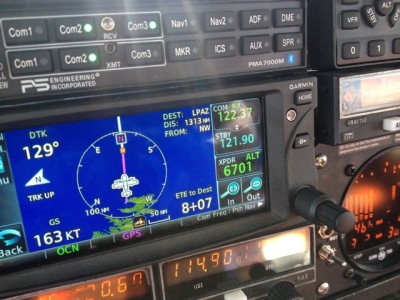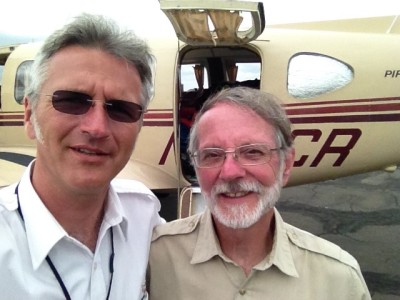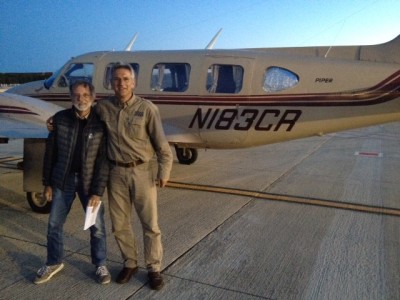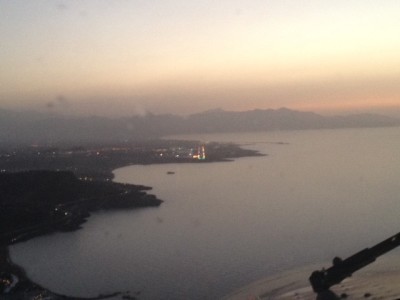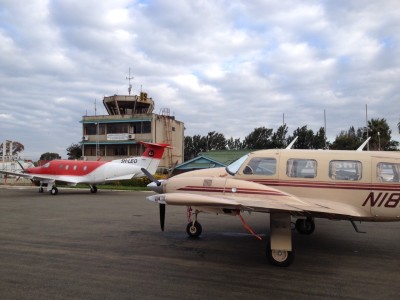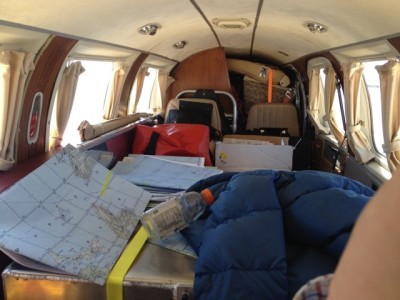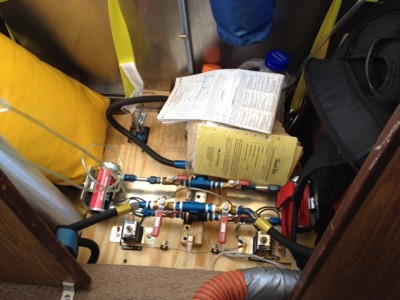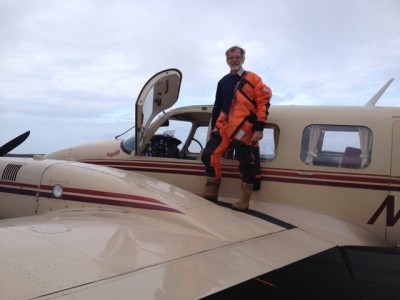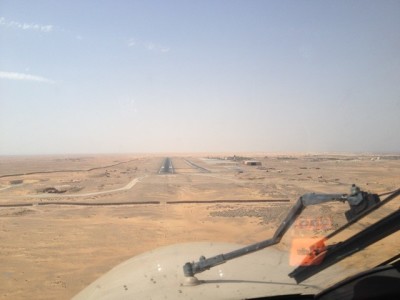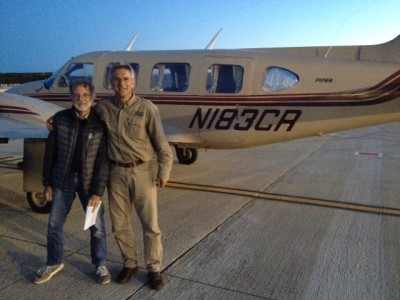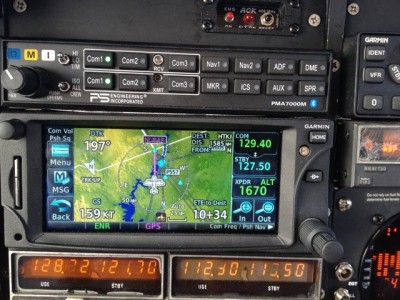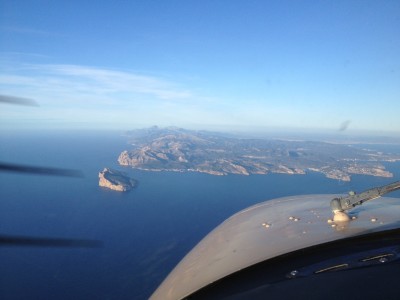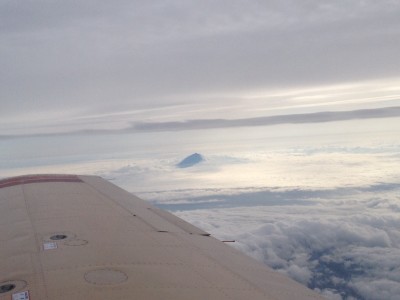Hello Mel,
My apologies for not writing sooner. I wanted to give the NAPP members a bit of a report on the half-way-around-the-world flight that Jack and I recently did, but things have a way of getting put on back burners here. Tanzania is always an exciting place to be. That said:
It’s a 1968 Piper Navajo. Eight seats. Two freshly overhauled turbocharged 310 horsepower engines, the left one of which doesn’t want to shut down properly. But it’s flied nicely for more than 25 hours. No one can figure out the left engine shut-down problem. We did a long shake-down trip, eight hours there and back, from Saint Louis Missouri to Pueblo Colorado. This was not the $50 hamburger but the $2,400 enchilada. The insurance company requires a minimum of 35 hours on the newly overhauled engines before flying across the ocean. The plane has been gone over with fine tooth comb (wire brush?). And it’s important to get it to Tanzania where Jack and his wife Sarah will put it into service as the first fully dedicated air ambulance in the country. 55 million people and one dedicated air ambulance in a country the size of Texas and Oklahoma put together!
So we start out on Friday morning May 6th. Now you have to realize that Jack left his wife and three kids in Tanzania in early December of last year. The plane had been promised to him fully ferry-able in September. So, with promises continually being pushed later and later, he went to Saint Louis in the beginning of December to help move things along. I fully expected to fly to the States in mid-December to bring the Navajo back with Jack to Tanzania for Christmas. Now it’s the morning of May 6th. There are at least 50 well-wishers at the hangar waiting for the departure of N183CR. Jack is a popular guy in Saint Louis. The Wings of Hope people there love him. He’s been written up in the diocesan newspaper. I’ve been in Saint Louis working together with Jack on the plane, all day every day, for the last two weeks. We still can’t seem to get key people to move. We’re ready to go, but the ferry permit is not ready. The 337 for the ferry tank is not yet signed. The OBS with the ILS shows two red flags but in fact works fine. A bit unnerving. A couple of post lights are still inoperative. But this plane is ready and we are going. We’ll fix the rest in Nairobi. Our U.S. customs eAPIS and the Canadian CANPASS are all sorted out. By 11 AM the paperwork is finished. Lots of hugs and kisses. Some tears shed here and there. Jack pushes the throttles forward and our trip almost begins.
Well the take-off was good. Gear up and locked. Sort of … locked momentarily, and then not. The nose gear came back down. This hasn’t happened before. We recycle. Same thing. Six minutes after take-off, we land again at Spirit of Saint Louis Airport. Nice that the the gear locks down and that the problem is with locking up. The farewell committee welcomes us with smiles but questioning faces. Two minutes of trouble shooting finds the culprit: a missing cotter pin and missing nut on the up-lock rod end. The bolt is still there, but it’s canted off to one side. Bolt repositioned. Nut on. Cotter pin in. Problem solved. But we spend the rest of the day trying to see why the left engine won’t shut down properly. By 5 PM we think it is all in order. But it’s late. We postpone our departure till Saturday morning.
On Saturday there are once again more than 50 people here. Hugs and kisses and tears. We get in. We take off. Gear up. And … the nose gear comes back down! We recycle it. Same thing. Six minutes later we are saying hello again to our farewell committee. The plane gets put on jacks. The hydraulic mule is connected. At least the problem clearly duplicates on the ground. After an hour of not being able to sort out the up-lock problem on the nose gear, I suggest we look at the maintenance manual. It says to lengthen the rod on the the up-lock latches. Then we find it. There is a lock nut that must have been on only finger tight. The gear had worked perfectly scores of times since the hydraulic system was rebuilt. But, we say, better a problem here in Saint Louis than on the way. We have our own hand tools in the plane, but a major hydraulic problem a thousand miles out is not a nice thought.
It is late afternoon. We take off. The gear comes up. It locks. And our trip begins. That was the last maintenance problem we had.
On our first leg: Saint Louis, Missouri, to Rockford, Illinois. Climbing from 10,000 to 13,000 feet. Really bad weather in between. We are certified for flight into known icing. We also have radar on board. We are both bush pilots. What the heck. But at about 11,000 feet the engines start missing. Both of them. Major fuel flow fluctuations. But the weather is not warm. Fuel pumps on. Problem solved. At 13,000 feet we level off, throttle back, and turn the electric fuel pumps off. Beautiful sounding engines. Weather not so beautiful. A line of thunder storms. But hey, with 13 hours endurance at 180 miles per hour, we can go around all sorts of weather. We do. Don’t have to divert far. We’re on the ground in Rockford one hour and 54 minutes after starting the engines. Nice flight. The left engine still wants to fly. We force it to shut down. We’ll have to do that every day, all the way to East Africa.
We overnight in Rockford, staying with a family who has financially supported this project and who has been supporting Jack’s wife’s work at Plaster House in Tanzania. Plaster House takes children who need orthopedic surgery and plastic surgery and keeps them out of the hospital setting as much as possible. They are prepped at Plaster House before surgery and cared for there after surgery. Built for 40, there are often 140 kids there at a time! Sarah says it’s a “high love, low cost” facility. It is.
We go to church Sunday morning with the Lutheran community which is supporting Plaster House and Arusha Medevac. Then on Sunday morning we take off from Rockford, climb to 13,000 feet with auxiliary fuel pumps on at 10,000 till we complete the climb. Our first water. Lake Michigan. We land in Pontiac, Michigan, at Oakland County Airport with a block to block time of 1.8 hours. My sister Colleen meets us at the airport with her brand new bright yellow Ford Mustang. We rest two days in Detroit with my brother and sister. It has been more than three years since I’ve seen them both. Two days are too short, but on Tuesday morning we take off from Pontiac and in a few minutes we are over Canada. Crummy weather at 13,000 feet. It clears up in 45 minutes or so. I tell ATC that Jack has never seen Niagra Falls and ask if we can see it. They are most cooperative and at 4,000 feet we do a couple of circles around the falls. Jack is thrilled. I am, too. Back up to 13,000 feet in a couple of minutes. Climbs nicely. Three-and-a-half hours after leaving Pontiac, we land in Lyndon, Vermont, where we are met by a mutual friend. She is a writer, the author of “Away from You”, a novel which begins in Arizona and ends in Tanzania; and “Shame” a novel short-listed for the “Not the Booker Prize” last year, which begins in Switzerland and ends in Tanzania and the Congo. Her husband is a wildlife photographer and Jack and I got to know Melanie and Matt when they were filming Disney’s first full-length nature film, “The Crimson Wing.” It’s about the flamingos on Lake Natron, a remote area of North-Central Tanzania where Flying Medical Service has 10 airstrips. We provide regular twice-monthly clinics there, among 16 other places, as we have for the past 33 years. Here, we are always flying in a National Geographic special.
Melanie and Matt and their two kids live on a mountain side. We watch a beautiful sunset, have a leisurely dinner, sleep by a wood stove (it was cold there that night), and get up early the following morning to fly about 55 minutes to Bangor, Maine. We refuel there. It is the first time the ferry tanks have been fully filled. We are 15% over gross, fairly typical for this type of ferry flight. The Navajo climbs beautifully to 13,000 feet as we begin the five-and-a-half hour trip to Saint John’s Newfoundland. It is minus 22 degrees Celsius up here, about minus eight Fahrenheit. Jack has his jacket in the front baggage locker. I have three layers of winter clothes on and am still freezing. We are laughing about it. We have chemical heat packs with us. We put a couple of the chemical warmers in our shoes and turn on the small exhaust-shroud heater on the left engine to (slightly) warm the cabin. No problem keeping those Coca Colas cold.
The Navajo had an old Janitrol heater in it. It was heavy. It wasn’t needed in East Africa. And it would have cost at least $ 3,000 to overhaul. We took it out and left it behind in Saint Louis.
It is coooold in Saint Johns Newfoundland on the 11th of May. We stay in a hotel with lots of oil rig workers. In the morning we go to the airport. Each of the 40 or so oil rig workers has a bright orange bag in hand. They figure they can put on their immersion suits if their aircraft goes down. Jack and I are wearing our immersion suits. He also has his jacket from the front luggage compartment. We’ve dropped a couple of chemical warmers down the sides of our legs. Our GPS data base ends here. We load the Atlantic data base which also covers Europe and Africa. It works. ATC gives us two latitude- longitude waypoints to fly to between Newfoundland and the Azores. OUR read-back is correct. After leaving Canadian airspace, we contact Boston on HF radio. There is a solid undercast. It is eight hours to Santa Maria airport on the furthest eastern end of the chain of the Azores islands. We took off later than we had planned. We would be landing in the early evening, flying away from the sun. There is a two hour and thirty minute time difference between Newfoundland and the Azores. The half-hour oddity is not in the Azores but in Newfoundland, which is an hour-and-a-half ahead of Toronto or New York.
Ceilings are forecast as 600 feet in rain and mist. Our alternate airport is Madeira island off the coast of Morocco. It is 545 miles further east. We might make it on fumes with a continuing good tail wind. An hour before reaching our destination we see, protruding up through the low undercast, the graceful 7,000 foot volcanic peak of mount Pico. But our airport is still 220 miles further east. Jack does a beautiful ILS approach to runway 18. The tower says welcome to Santa Maria. We truly feel welcomed! We had just flown 1,581 miles over a large part of the Atlantic ocean. I say to the controller, “We were expecting worse weather.” He answers, “You should have tried landing half-an-hour-ago!” Another hour and the rain and mist lower the ceilings and it is dark.
We are thrilled to be on this beautiful island. We sleep. We rent bicycles the following day and ride to a lovely beach where there are a few people swimming, a couple of cars parked, and a saddled horse standing in one of the parking places waiting for its rider.
The following morning, well rested, we refuel and take off on the 1,522 mile flight to Son Bonnet airfield on the island of Mallorca (or Majorca). Seventy percent of this trip is also over water. Everything has been perfect until ten minutes out of Son Bonnet. ATC says that the airport is closed! As there is no tower there, only advisory services, we ask if we can land anyway. Nope. Land at Palma de Majorca, we are told. Okay, we say. They say, maintain VFR north of the island and we will fit you in. If you have never been to Majorca, you would think this is just fine. We have just flown for eight hours non-stop, but fuel is no problem; we still have at least four hours remaining. After about 45 minutes, and with the sun beginning to set, approach calls and says: Charlie Romeo, keep up your speed, we can fit you in now. You will be number 12 for landing! The place is like JFK. For as far as you can see to the east are the landing lights of scores of jets on approach to landing.
We land and park. But busy as Palma airport is, there is no avgas. In the morning we hop (only IFR departures allowed) from Palma to Son Bonnet, about two minutes away. Now departing Son Bonnet is an entire story in itself, but we finally just leave. It takes us about 20 minutes to pick up an airborne clearance to fly at 12,000 feet eastbound. That’s right. East. So we do as we are told. And seven hours and 25 minutes after starting our taxi roll, we land at night on the beautiful island of Crete. We sleep there two nights. The rest is welcome.
On the morning of May 17th we refuel and leave Iraklion airport to fly south across the Mediterranean. Jack and I have done this before when, several years earlier, we flew a Cessna 206 from the Netherlands to Tanzania via Crete. But today is different. We’re much faster. Egypt is on a red security alert. Our charts say clearly and in big print: Do not enter Egyptian airspace unless in contact with Cairo at least 15 minutes beforehand. We can’t raise them. Crete has handed us over. Nothing. We’re now much closer than 15 minutes. However, this is Africa. We are now approaching our home continent. We’ve been living on Coca Cola and Slim Jims which Jack insists on calling Long Johns. I tell him those are something different. He still likes Long Johns.
Now on the African continent, there are vast areas of theoretically “controlled airspace” in which you cannot contact air traffic control. So, VFR or IFR, you just go. You call them when you are in range, usually 50 miles or so from your destination. Plenty of time. But we might have a different situation here. We don’t know. Egypt is very unstable. We can’t get through to Cairo Control on either the low altitude or the high altitude sector frequencies. Two minutes before entering their airspace, we ask an airliner to contact Cairo for us. Don’t worry, we are told by the airline crew, Cairo has you on radar. As we approach Alexandria and dry land once again, we finally get a friendly Egyptian controller. We are given a course which takes us 100 miles beyond our destination and then doubles back a bit further east to avoid temporary military activity. There is no charted MOA anywhere near where we are. We ask if we can go higher and go more direct. They ask us if we can do 21,000 feet. Sure we can. Mount Kilimanjaro is in our back yard at home in Tanzania. It is nearly 20,000 feet. Jack and I have both done it on foot without oxygen. But we do have oxygen with us in the plane. We start climbing, struggle a bit with the oxygen cannulas (you can’t clamp them under the earmuffs on the headsets or you don’t get oxygen!), and we continue on our way, more or less direct. The following day, right where we had the problem contacting ATC, EgyptAir flight 804 enroute from Paris to Cairo, crashed into the sea with the loss of all 66 onboard.
We shut down the engines at Aswan airport five hours and thirty-five minutes after starting in Crete. There was a heat warning for Egypt which is always hot anyway. But today it is a blistering 47 degrees Celsius or over 116 Fahrenheit in the shade. We had to refuel in the sun. But at zero humidity, you don’t sweat.
Egypt is a sad place. We were put up in a genuine five star hotel on an island in the middle of the Nile, reachable by private boat. The hotel has 500 luxury rooms, a splendid staff and food, all for a price less than that of a Motel 6. There were only three rooms occupied in the whole place. The economy is in total collapse. Tourist boats line the river banks. They haven’t been used in years.
We went to the top of the hotel and watched a beautiful sunset over the desert sands stretching far to the west. Most of the flying in Egypt and Sudan was IFR. The dust was still thick at 21,000 feet and rose high above us. Sometimes we could see the ground at 13,000 feet, but not often. The dust makes for spectacular sunsets.
On the morning of the 18th of May we left Aswan. It was still an oven. We had full main tanks and a full ferry tank. The ferry tank gave us an extra 150 gallons or about 5 hours over and above the Navajo’s regular 8 hour economy endurance. We were planning on doing our longest unrefueled flight today: 1,935 miles from Aswan to Kilimanjaro to Arusha. But the climb performance at 116 degrees and 15% over gross was less than normal, though still quite good. Unfortunately, for the first four hours, our ground speed was a dismal 147 knots instead of the 180 to 200 that we were experiencing till that day. We were getting too far south for the prevailing westerlies to prevail. We burned off an hour in the main tanks and then started on the ferry tank. We emptied it. Jack calculated that we couldn’t even make Juba in South Sudan at this rate. There was no avgas in Khartoum. And anyway, the last time we bought 100 LL there, it cost us $ 25 a gallon in drums which had the previous year as an expiry date. But, if we couldn’t make it to Juba, we had little other choice but to land in Khartoum or return to Aswan and wait for better winds. Jack’s family were going to meet us at Arusha airport in the late afternoon. We wouldn’t be there. And then the headwinds diminished. Jack went to the back of the plane and unstrapped the ferry tank. He lifted it up in the rear so that we could drain the last bit of otherwise unusable fuel. At 160 knots ground speed we could make Juba, the capital of South Sudan. There is no avgas there either, but we have friends who live there. We could truck the fuel in from Nairobi if we had to.
So, Juba it would be. But then our ground speed picked up. We could make Eldoret in Kenya. If winds stayed favorable, we might even be able to get to Nairobi. Onboard radar showed a broad line of nasty thunderstorms between us and Nairobi. We decided we could make it there, but no further without compromising safety. One more problem: we only had overflight clearances for Sudan, Uganda and Kenya; but we would have to land in Kenya. By now, on HF radio we were able to contact our Flying Medical Service pilot, Mike Neville-Rolfe, who was at our office in Arusha, Tanzania, 500 miles further south. Mike phoned a clearing company in Houston. They in turn got in touch with a commercial clearance operator in Nairobi and promised us a landing clearance. We got it after we landed. But that was okay. We were home for all practical purposes. We know lots of people at Wilson airport in Nairobi, the busiest airport in all of Africa. But we weren’t really there yet. The thunderstorms looked nasty. Our fuel situation was not too generous. We had already been 10 hours in the air, moving far more slowly that we ever had before. We got tossed around quite a bit, but just after being cleared for the instrument approach into Nairobi, we broke into clear air with Wilson airport in sight. We shut down the engines 11 hours and 12 minutes after we started them in Aswan. It was a good feeling. On the other hand, we both felt good enough to have kept flying.
There was heavy rain in Nairobi that night. The following morning saw some pretty bad weather as well. We were in the clouds most of the way to Kilimanjaro airport. But the outside air temperature was plenty warm. We landed at Kilimanjaro in mid-morning, cleared customs and immigration, but our flight clearance from the day before was no longer valid. We waited most of the day to get cleared to fly the last 30 miles to our home base at Arusha airport. And eventually we did. The welcome was great. Jack’s wife and kids were there with all of their school friends. The whole Flying Medical Service crew was also present. I certainly had more champagne poured over the top of my head that afternoon than got into my mouth. Jack fared better.
That was the end of a 9,303 mile ferry flight. It, however, begins a new chapter in health care in Tanzania. Hopefully within another week or two, after all the paperwork is complete, the Navajo with the registration 5Y-ZOG (that’s another story) will become the first aircraft for the new Arusha Medevac. Flying Medical Service, with our two Cessna 206s is still very much alive, treating and vaccinating more than 30,000 patients a year. Till now, we have squeezed another 150 medical emergency flights into that already busy clinic schedule. With Jack and Sara’s new air ambulance Navajo, fresh other possibilities begin.
— some photos to follow:
